Lowell Board Administrator Username: Lowell Post Number: 2766 Registered: 10-2003 Posted From: 66.167.59.60 |
This side exchange in the 'jjaba's 4000th post' thread in the Connections Forum was so wonderful I decided to use it to start a thread over here...
| ||
Pdtpuck Member Username: Pdtpuck Post Number: 96 Registered: 01-2006 Posted From: 208.251.168.194 |
unfortunately, elms graced so many streets EVERYWHERE!!! chestnut blight wiped out many a beautiful chestnut tree, too. we've got one around the corner from us, and whenever the sprouts get big enough to look good, the blight destroys them. Morton Arboretum in Lisle, near Chicago, was doing tests on such a thing back in the 90's, but don't know if anything ever came of it. And frankly, Chinese elms just don't cut the mustard like the American elm did!!! | ||
Lowell Board Administrator Username: Lowell Post Number: 2767 Registered: 10-2003 Posted From: 66.167.59.60 |
I once had picture of my Highland Park house that came with a 1940 survey. The street was a tunnel with a bower of immense elms from end to end. At the time I bought the house, early 70's, Dutch elm was ravaging the neighborhood and, one by one, they all died. It was like a slow motion massacre. You kept hoping one would survive, then you would see dead leafs at the top and two years later a huge skeleton remained. It was so sad. Being a Sears’s delivery driver in those days, I saw this played out all over the neighborhoods of Detroit as a once leafy city was laid bare. The Pointes, with great expense, defended and saved many of their elms, but the casualty rate there was still probably 50%. Ray's leaf burning stories remind me of another unique visual effect of the elms. In the fall their leaves would turn a bright yellow gold. To see those gold tunnels illuminated by the sun was magic. Then they fell to the ground and turned everything gold. | ||
Jjaba Member Username: Jjaba Post Number: 4048 Registered: 11-2003 Posted From: 67.171.136.201 |
We remember skidding on the leaves when it rained in the Fall. Remember that? jjaba, Westsider. | ||
Hysteria Member Username: Hysteria Post Number: 672 Registered: 02-2006 Posted From: 152.163.100.8 |
Courtesy Detroit News: 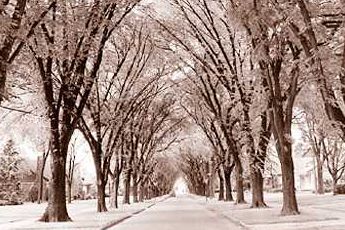 Graceful elms provide a cathredal ceiling over Archdale Street looking north from Schoolcraft in 1957. Perhaps if they had not been so beautiful. Perhaps if they had been planted 100 feet apart instead of 40. Perhaps if the space between the sidewalk and the curb had been wider. Perhaps if the homeowners had watered them. Perhaps if the European beetle had not arrived in this country in a load of infected elm wood for furniture. Then maybe Detroit would still have some of the lofty elm trees that formed vaulted cathedral-like tunnels of shade over neighborhood streets. During the 1930s some Netherlandish beetles that lived in elm bark and carried a deadly fungus came to ravish America's beloved elms. Most cities had chosen the fast growing elm to shade neighborhood streets. Detroit planted over 400,000 trees on city land, between sidewalks and street curbs. The saplings quickly grew to enormous size, up to 120 feet tall.. But the quick growth soon caused the wide tree trunks to lift sidewalks and attack the curbs. Crews replaced the uplifted sidewalk sections with curved sections to avoid the encroaching trunks. Two boys ride past an elm tree on Hessel Street between Glastonbury and Faust. The beloved trees seemed to protect the homes. Homes surrounded by the shade trees seemed not to need air conditioning. The leaves allowed filtered sunlight to attract the eye heavenward, and indeed most who recall the trees, describe the arches of elm branches in terms of cathedral vaults used by medieval church architects to lift the spirit. In 1950 the first case of Dutch elm disease appeared in Detroit. It quickly spread, with cases reported on Korte Street, Chandler Park, Gratiot and Eight Mile, Jefferson and Conner, and on Manor Avenur near Meyers and Plymouth Roads. Detroit decided to try to save the trees by spraying DDT by helicopter. DDT, legal at the time, did kill insects. It also killed birds and threatened pets and children, according to environmentalists. Parents kept their kids indoors while the copters sprayed. Lawyers considered lawsuits for the delicate who might suffer a reaction from the chemicals. Bird lovers counted bodies, but also mourned the loss of the homes for the birds, the very trees the helicopters were trying to save. Later Methoxychlor replaced DDT, but it was found to kill fish. The chemical was not to be allowed to get into the sewer system. But how was the rain to know when it washed over the sprayed tree leaves? Lawsuits weren't the only problem. Even Lloyd's of London refused insurance to cover the spraying. Detroit's efforts to save the trees did delay the inevitable long enough to develop a manageable tree removal system. Toledo had decided not to spray, and lost almost all their trees quickly. Falling branches and storm-felled became a serious problem. Des Moines, Iowa, which also did no prevention, lost 90 percent of its trees within a decade, leaving the tree-lined neighborhoods dusty and wind-swept. Property values, and tax revenues based on those values, also dropped while the costs of tree removal soared for most stricken cities. During the early 1950s Detroit lost only 2,000 trees per year, a small enough number to keep the crews at an even pace, and to help spread the cost out over a longer period. In 1965 a drought hit, adding more stress to the trees. The removal pace hit about 10,000 trees per year, until 1972, when the city had taken down 100,000 trees over the previous 21 years. In 1970 Detroit paid $500,000 for tree removal and $300,000 for spraying, which seemed to delay the deaths of the elms. In a 1968 Michigan State University extension bulletin, researchers estimated that Michigan had about 5 million elm shade trees still alive, and their value was more than $700 million. Property owners bore the cost of removal, usually about $1,000 per tree. City workers warned delinquent homeowners to hurry it up, or pay the city for removal. 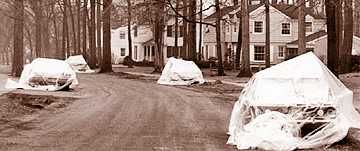 Cars wrapped in plastice to protect them from spraying line a Birmingham street in 1966. Pollution rules required that cut trees were only to be disposed of in approved and expensive burial dumps. Detroit began to violate the no-burn law and burned the trees in big piles on Belle Isle. After the epidemic had run its course, hindsight proved that the efforts to maintain tree health had been the least costly approach to the problem The prevention efforts only delayed the inevitable, but allowed an orderly transition, as other varieties of trees replaced the elms. But homeowners still mourned their elms. Michigan lost 80 percent of its shade elms. Scientists have been working on finding a resistant elm since the 1930s with little success. However, some lessons learned include spreading new plantings far apart so the beetles can't attack so quickly. Some chemicals may help keep some trees alive longer. Large watered lawns, such as in Grosse Pointe seem to allow for healthier, more resistant trees. Variety in planting choices might prevent any disease from wiping out vast numbers of identical trees. Researchers may yet find a perfect resistant elm to come back and shade us. 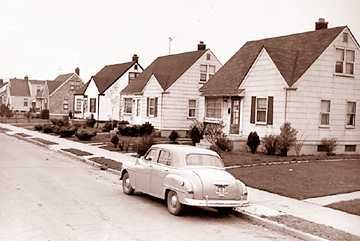 A tree-denuded Bassett Street in southwest Detroit in 1951. http://info.detnews.com/history/story/index.cfm?id=9&category=life | ||
Paulmcall Member Username: Paulmcall Post Number: 761 Registered: 05-2004 Posted From: 68.40.119.216 |
I'm curious to know when they built those houses on Basset Street. I lived on Winthrop (on the NW side) and there were a lot of open lots back then (1951-1956 or so) and many trees had not been planted yet. | ||
Mackinaw Member Username: Mackinaw Post Number: 1830 Registered: 02-2005 Posted From: 71.144.116.243 |
Yes the Elm trees are a great memory from my youth. Most houses had two in front of them near the road in Grosse Pointe (much like Detroit), and by the 1990s, right before they were all taken down, my street was framed by these awesome 100-footers. For the last ten years with all but a couple of these trees having been removed from my street, our local environment/streetscape has lost a lot of character. And even when the new trees grow tall, it will not be the same because the plantings are a mix of different species, none of which will create the cathedral-like canopy. | ||
Ray1936 Member Username: Ray1936 Post Number: 677 Registered: 01-2005 Posted From: 207.200.116.139 |
Good thread; great read. When the John Lodge was extended from Wyoming out to the 'burbs, the street was known as James Couzens, a divided roadway with an 80-foot island separating the pavement. Those boulevard islands were thick with elm trees the entire length out to Eight Mile. In 1962, construction for the extention began, and the first job was to take down those elm trees. I watched it happen, and couldn't believe how fast they took 'em down. A huge front-loader would scoop out a bucket of dirt on the side of the tree for the direction they wanted it to fall, and then go around to the opposite side and just push it over. I think they took down all those trees in just a week. Joyce Kilmer would have been most unhappy. | ||
Goat Member Username: Goat Post Number: 8586 Registered: 10-2003 Posted From: 70.54.70.136 |
Too bad the Emerald Ash Borer is doing the same today. I am glad that they (scientists) have since introduced an Elm tree that is much hardier than their predecessor. | ||
Livernoisyard Member Username: Livernoisyard Post Number: 1013 Registered: 10-2004 Posted From: 69.242.223.42 |
"And even when the new trees grow tall, it will not be the same because the plantings are a mix of different species, none of which will create the cathedral-like canopy." Punk kids killed more new trees than any insect infestations. They're already killing some the dozens of new trees off Lonyo south of Michigan. | ||
Gistok Member Username: Gistok Post Number: 2387 Registered: 08-2004 Posted From: 4.229.72.152 |
The last Grosse Pointe streets that had the "vaulted Cathedral" effect were Washington and Lincoln in Grosse Pte. One of them still has a stretch with that vaulted effect. My family home on Marseilles, not far from Grosse Pte. had 4 large Elms, all lost in 1965. The neighbor 2 doors down still has one of her huge Elms, now 120 ft. tall. She put some kind of black plastic collar (also keeps squirrels off the tree) around her tree trunks, and it seemed to have protected it, along with occasional spraying. | ||
Mackinaw Member Username: Mackinaw Post Number: 1831 Registered: 02-2005 Posted From: 71.144.116.243 |
So, do I read correctly that in Detroit most of the Elms started to get cut down in the 60s, and were mostly gone by the 70s? I was lucky then, being on one of the streets that Gistok mentioned, which kept the vast majority of its elms until the 90s, but I emphasize just a few. Gistok--today neither of those streets have anything more than spotty Elm coverage, so that canopy effect is lost. There are a few random blocks across the older Pointes that have a succession of old elms to create the effect. | ||
Hysteria Member Username: Hysteria Post Number: 675 Registered: 02-2006 Posted From: 152.163.100.8 |
That is correct. The drought of '65 made the trees more vulnerable to the beetle. The picture of the cars on the residential street in Birmingham seems so strange. | ||
Livernoisyard Member Username: Livernoisyard Post Number: 1015 Registered: 10-2004 Posted From: 69.242.223.42 |
Milwaukee's first Dutch Elm diagnosis was made in 1955. [Rockford IL and other cities waited too late and lost them all.] Greening Milwaukee: By 1955, the first case of DED occurred on the East Side of Milwaukee and eliminated much of the tree canopy in the city. 128,000 Elm trees lived on Milwaukee streets in 1950 while only 6,000 remain today. | ||
Jjaba Member Username: Jjaba Post Number: 4049 Registered: 11-2003 Posted From: 67.171.136.201 |
They wewren't watered, they had disease, they had to battle the asphalt, they had to live too close to cement, they breathed diesel fumes, people put three inch nails in them for signs or fencing, and now we wonder why? jjaba, with great memories of the Elm trees. | ||
Ray1936 Member Username: Ray1936 Post Number: 680 Registered: 01-2005 Posted From: 207.200.116.139 |
I had forgotten how the roots would push up the concrete slabs for the adjacent sidewalks. I dont think there was a straight, level sidewalk on the west side of town because of it. Probably more than one lawyer made a living on 'trip and fall' matters back then. | ||
Treelock Member Username: Treelock Post Number: 138 Registered: 03-2005 Posted From: 68.77.166.98 |
The newer generation may have similar memories one day of the beloved ash trees, which now appear as a blight upon the landscape of southeast Michigan in wood lots, forests and road medians. Travel out of the region and return, and you really realize the severity of the infestation. The irony is that ash was used as a primary replacement for the American elm. | ||
Hysteria Member Username: Hysteria Post Number: 677 Registered: 02-2006 Posted From: 152.163.100.8 |
According to Wikipedia, over 25 million elm trees died in the U.K. from the disease. That is unbelievable! I wonder what the American number was? Wikipedia also states that the disease didn't reach western Canada (Saskatchewan)until 1981. Alberta and British Columbia are the only provinces that are currently free of Dutch elm disease, although an elm tree in southeastern Alberta was found diseased in 1998 and was immediately destroyed before the disease could spread any further. Thus, this was an isolated case. Today, Alberta has the largest number of elms unaffected by Dutch elm disease in the world. AMAZING! | ||
Ray1936 Member Username: Ray1936 Post Number: 683 Registered: 01-2005 Posted From: 207.200.116.139 |
"O, Canada, You have a lot of trees, O, Canada, Without dutch elm disease" (With apologies to AIW and goat; I think your national anthem is among the best.) | ||
Rustic Member Username: Rustic Post Number: 2614 Registered: 10-2003 Posted From: 71.234.183.131 |
The elm trees were so dense that their seeds in the late spring would rain down like snow and you could sweep up your driveway and get bushels of the seeds. Anoyone else rmember that? The house on the corner of my block growing up in NW detroit had 8 elm trees on the lot. this wasn't a double lot either. 2 remain. The house behind us had 4 elm trees, one remains. I have heard that had the elms been planted less dense the disease would not have been so devastating. The town I now live in has some ancient elms that were early surivors of dutch elm disease and I understand they have been used in the disease resistant hybrids. Ray's mention of the sidewalks tilted by the roots is exactly right. As kids we would know which sidewalks were tilted just right to use as bike ramps to jump. Three more things about the elm trees in Detroit (1) first the shade. these big trees towering a couple of stories above the houses shaded them from the hot sun. stepping offa broiling hot Grand River into my leafy neighbothood back when the elms ruled the skies felt like a good 10 degree drop. (2) the sound insulation. after the trees were cut down it was significantly louder. noticably louder. (3) the sound of the branches blowing the night wind, the leaves rustling and the limbs creaking up high overhead was creepy. | ||
Pdtpuck Member Username: Pdtpuck Post Number: 101 Registered: 01-2006 Posted From: 208.251.168.194 |
Don't forget puppy piss and "lawnmower blight!" (people running into the trunks and roots with their lawnmowers, for the un-initiated!) | ||
Jerome81 Member Username: Jerome81 Post Number: 1034 Registered: 11-2003 Posted From: 64.142.86.133 |
Wish I could have seen it. So how come they lasted so long befor the disease? Was the disease not known about when they were all planted? Are the new Elms resistant? Be nice to plant them again. What are all the trees currently in GPP? They have a nice look to them, but I don't know if they qualify as "canopy". Is there anywhere where I can go to experience it, and then imagine what it was once like (like you so often have to do with Detroit)? | ||
Ilovedetroit Member Username: Ilovedetroit Post Number: 2357 Registered: 02-2005 Posted From: 69.246.54.234 |
What a nice thread. | ||
Mackinaw Member Username: Mackinaw Post Number: 1832 Registered: 02-2005 Posted From: 70.141.77.56 |
Jerome, GP Park has a mix of a few remaining elms, and plenty of other mature trees, so it's a very well-shaded city. Still, you can feel the discontinuity, even on some of the nicest streets like Berkshire, where you have a couple big trees, and then some lots with little trees out by the road and very little shade. What's funny is that, on one of the streets Gistok mentioned--Washington in GP, there is one big elm tree at the first house of Mack near the Detroit border, and then no more for a long stretch. There is a decent canopy on Washington between Kercheval and St. Paul if you want to drive this street. I want to say that Cloverly in GP Farms-- the boulevard section east of Ridge -- has several elms left. I'll let you know if I see any good spots, but like I say, there's really noplace where you can still witness the full effect of the former urban forest. | ||
Goat Member Username: Goat Post Number: 8596 Registered: 10-2003 Posted From: 70.54.70.136 |
Thanks Ray1936 but we didn't write it.  Though I do enjoy the score of the USA's national anthem as well. In Windsor (and I am sure in Detroit as well)maple trees have become the new cathedral for many streets so though I never had the chance to see the elm tree's of the past, the maple trees seem to be a good replacement. I just wish more would be planted. BTW: I agree, nice thread for a change. | ||
Southwestmap Member Username: Southwestmap Post Number: 507 Registered: 01-2005 Posted From: 70.229.231.102 |
My street has several silver maple trees and I dislike thm so much - although I hope they don't know that. They are a lot messier than elms. Maple spinners are a plague that I never have the time to completely clean up. Also, while shady, they are much more scraggily than the elms were. The elms were visual poetry with their vase-shaped silhouettes. One early memory is driving down Chalmers from Jefferson to the river, a street my family would later live on, and my parents pointing out the cathedral-like canopy that the elms made. We were living in a G. I. loan house in tree-less Roseville at the time and my parents longed for the tree-shaded streets of their youth. Later, living on Chalmers near the river, we would notice a big drop in temperature in the summer just as soon as we turned off Jefferson and headed down the tree-lined street. There was such dignity and grandness to the elm lined streets that we felt almost as if we were rich kids. | ||
Rustic Member Username: Rustic Post Number: 2616 Registered: 10-2003 Posted From: 130.132.177.245 |
The elm trees with the virtually continuous canopy overhead had two effects on childhood games. Generally the leaves were way too high to hit throwing a baseball or football but ... (1) it made us devise complicated grounds rules (specifc to each kids house) when playing "500" in the street since a hiiiigh fair fly could (in principle) hit the leaves so that possibily needed to be addressed and (2) made shooting up bottle rockets a complicated exercise in careful aiming windage etc. Re Detroit elms I know of one street that still has a fair number of curbside elms. One of the streets between Lyndon and Schoolcraft and Asthon and Warwick still has a stretch of elms. I'm not sure which street it is. These are not as fat trunked or as wide canopied as the elms were in the olden tymes (no suprise the narrower scrawnier ones survived curbside) but it is what it is and worth a drive to see. This would be in the Grandmont-2 neighborhood. Bvos would probably know which street I'm talking about. The elms gave an organic version of a gothic arch over the street. It was a quite beautiful effect esp for detroit's generally narrow and straight residential streets. You didn't really see the leaves, just the trunks and weighty limbs. For an idea of what replacement trees will look like as they mature check out Rutland in grandmont for an Maple example. The maple effect is more of a lower flat arch. beautiful but not lofty. One advantage of Maples is greater color variation in the fall over elms. For me the loss of the elm trees co-indiced exactly with the peak of white flight out of my neighborhood growing up. This was mere co-incidence I know, had I grown up a mile or so east or west this would not have been the case but it is a strong allegorical connection to me. In fact when I read a book that took place in suburban Detroit that made dutch elm disease loss an allegory to something else entirely it just rang completely false to me. Yay Detroit! (Message edited by rustic on July 05, 2006) | ||
Downtown_dave Member Username: Downtown_dave Post Number: 80 Registered: 07-2005 Posted From: 63.77.247.130 |
I grew up with a silver maple in my backyard that shaded the whole yard. As a kid, the "helicopters" were fun raining down in the seed season, but the tree was always dropping twigs and its shaggy bark, and was generally pretty messy, as Southwestmap noted. In the yard behind ours grew a HUGE elm that shaded our maple and dropped thousands of the little "oatmeal-like" seeds everywhere. One branch had grown completely around the Detroit Edison wires above the lot line. When that elm was finally removed, the part that enveloped the wire was left hanging there - and may still be there today for all I know. Some of the most magnificent elms I remember shaded the grounds of the Dearborn Inn - their classic tall vase shape and wide umbrella crown the perfect accompaniment to this brick Georgian-Colonial building. | ||
Southwestmap Member Username: Southwestmap Post Number: 508 Registered: 01-2005 Posted From: 70.229.231.102 |
Rustic: the link between the loss of the elms, which left the streets of Detroit barren and shelterless, and epic "white flight" may be quite real. Research out of the University of Illinois found a "correlation between safety and trees, which appear to have a calming effct on city dwellers." Researchers found that almost twice as many women who lived in buildings with no landscaping reported engaging in violence than women from buildings with trees. Women who loved in barren housing communities were about four times more likely to have used a gun or a knife or threatened to, during a conflict than women from tree-landscaped dwellings. A companion study done by the same team at another housing community found that trees and grass foster more creative play among youngsters. The researchers wrote that urban forests are as necessary as streets, sewers and electricity. | ||
Rustic Member Username: Rustic Post Number: 2621 Registered: 10-2003 Posted From: 130.132.177.245 |
SWmap, can't speak for the study but the simple fact is had I grown up on GR and schoolcraft instead of GR fenkell the neighborhood would "changed" before dutch elm disease hit. Had I grown up on GR and and McNicholls the trees woulda been cut down before the neighborhood "changed". So, for me the correlation is mere circumstance and I recoginze it as allegorical. Further the whites who flit back then flew to treeless greenfield sites (e.g. no problem flying kites or shooting up model rockets in Farmington hills back then, not much to rake up in Livonia either, hell even what was said to be verdant Plymouth felt more like farmland than parkland back then). | ||
Mackinaw Member Username: Mackinaw Post Number: 1833 Registered: 02-2005 Posted From: 70.233.3.55 |
Agreed about the need for an urban forest... In my backyard and in neighboring backyards are a mix of older silver and sugar maples. The Silver maple right near my house is messy, especially in early June. They are tall and have nice bark, but these varieties grow in irregular shapes when you give them room to, and thus they are not as stately as an elm canopy. | ||
Hysteria Member Username: Hysteria Post Number: 689 Registered: 02-2006 Posted From: 216.223.168.132 |
My neighborhood is full of Locust trees. There is a 40' - 50' Locust in front of my townhouse. The leaves are very small and when the wind blows they sound similar to Aspen trees. | ||
Eastsidedog Member Username: Eastsidedog Post Number: 605 Registered: 03-2006 Posted From: 12.47.224.8 |
Sorry I'm not of the elm generation. I grew up with maples which are great climbing trees! BTW, great thread!  | ||
Eastsidedog Member Username: Eastsidedog Post Number: 606 Registered: 03-2006 Posted From: 12.47.224.8 |
So are those Locust trees on Parker St. between Lafayette and Agnes? I love that street!  | ||
Hysteria Member Username: Hysteria Post Number: 691 Registered: 02-2006 Posted From: 216.223.168.132 |
Haha ... No, I live in South Bend, IN. | ||
Eastsidedog Member Username: Eastsidedog Post Number: 608 Registered: 03-2006 Posted From: 12.47.224.8 |
Didn't say you lived there Hysteria. But I know some people on the forum do live in the area. Dabirch? | ||
Hysteria Member Username: Hysteria Post Number: 692 Registered: 02-2006 Posted From: 216.223.168.132 |
I see ... I guess it depends how you read the question.  | ||
Eastsidedog Member Username: Eastsidedog Post Number: 609 Registered: 03-2006 Posted From: 12.47.224.8 |
It's true. It's true. | ||
Rustic Member Username: Rustic Post Number: 2622 Registered: 10-2003 Posted From: 128.36.14.165 |
Da birch, da elm, da maple, all a dem trees ... | ||
Livernoisyard Member Username: Livernoisyard Post Number: 1022 Registered: 10-2004 Posted From: 69.242.223.42 |
Speaking of da birch... The city planted some of them in SW Detroit. Trivia question--where? | ||
Jjaba Member Username: Jjaba Post Number: 4052 Registered: 11-2003 Posted From: 67.171.136.201 |
Birch are more decorative and they grow fast and die. Not a good choice. Aspen is another which grows fast and die after spreading shoots everywhere. Not a good choice. Maples are ok but they fall over easily in storms. There's nothing like the elm canopy and we miss them. Excellent thread. Thanks. jjaba. | ||
401frank Member Username: 401frank Post Number: 4 Registered: 12-2005 Posted From: 70.235.62.238 |
I live in Boston Edison on Longfellow and still have a nice elm at the end of the street near Woodward. It inspired me to search out disease-resistant elms and plant one in my front yard. I found a place called the Elm Research Institute that sells true american elms called "liberty elms" that should hold up against Dutch elm disease. I bought a six foot one in 1995 and now it's almost as tall as my house (25 feet or so). Their website is http://www.landscapeelms.com/i ndex.htm You'll have to poke around a bit to find ordering information. (Message edited by 401frank on July 06, 2006) | ||
Mikem Member Username: Mikem Post Number: 2620 Registered: 10-2003 Posted From: 68.43.15.105 |
I knew Lowell would eventually get around to an apartment ruins tour, but I've also been waiting for a Fabulous Tree Ruins webisode:  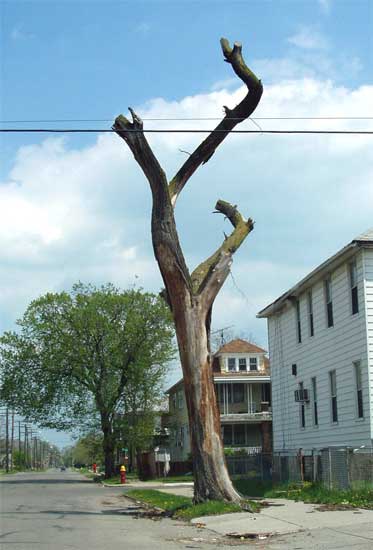 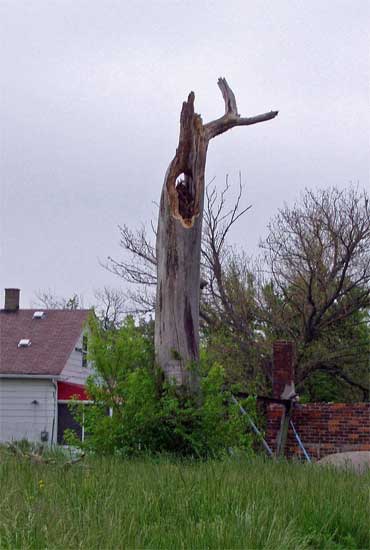 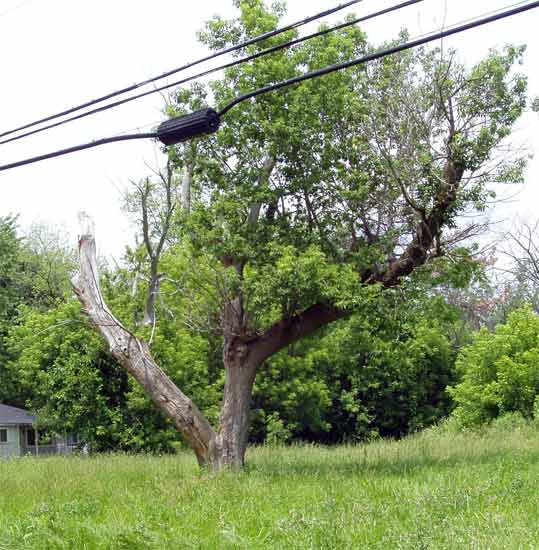 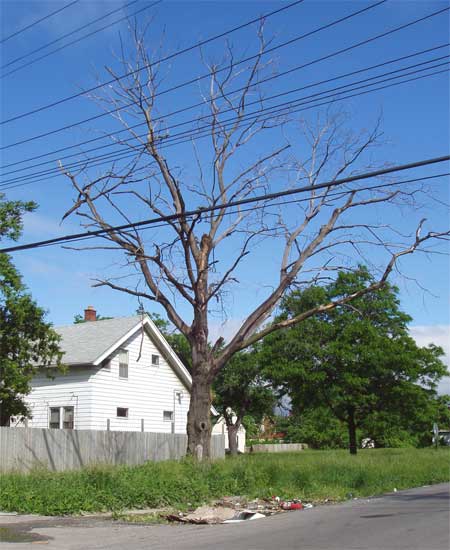 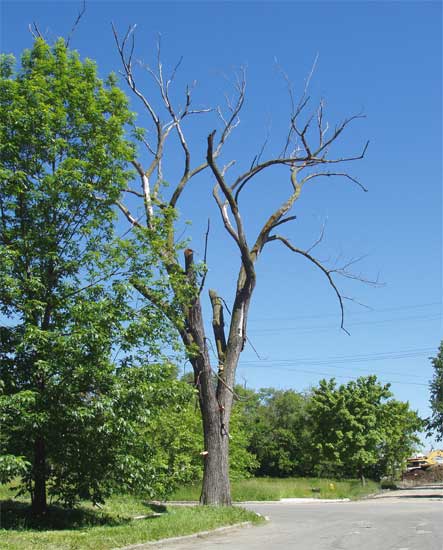 | ||
Mikem Member Username: Mikem Post Number: 2621 Registered: 10-2003 Posted From: 68.43.15.105 |
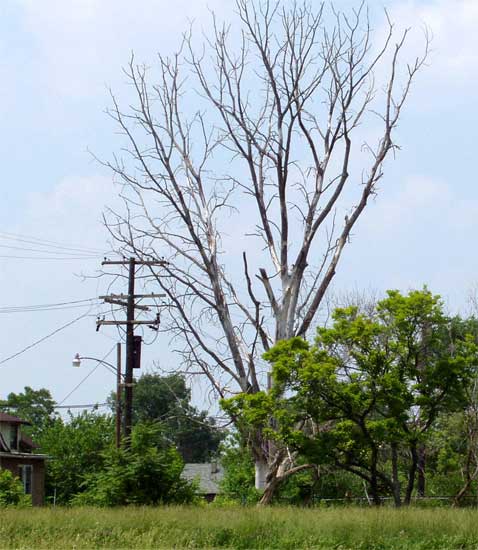 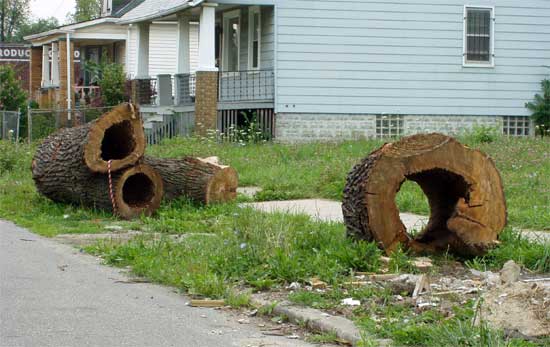 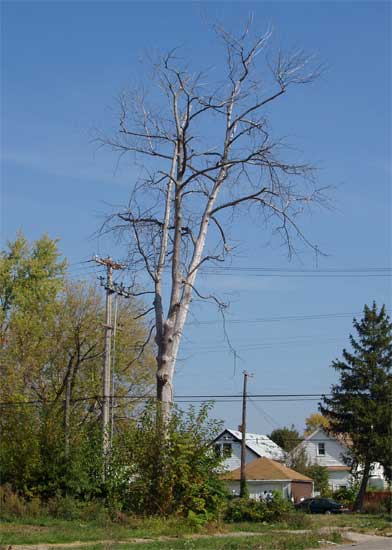 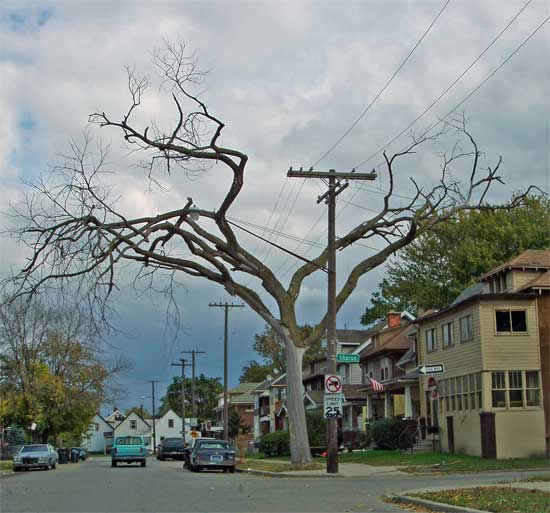 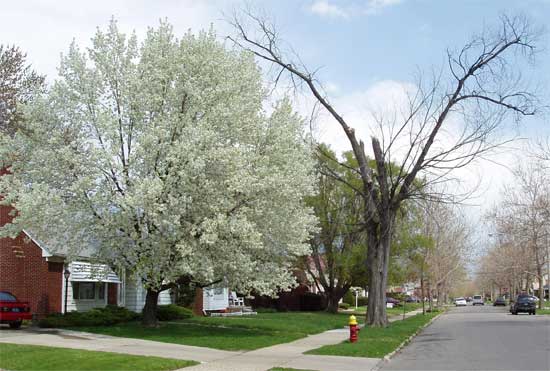 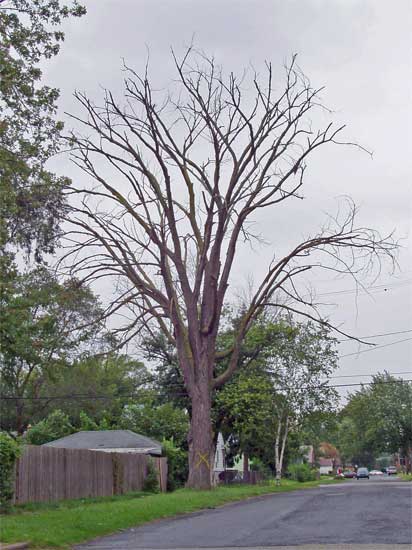 | ||
Mackinaw Member Username: Mackinaw Post Number: 1835 Registered: 02-2005 Posted From: 75.10.21.237 |
tear that schitt down | ||
Jsmyers Member Username: Jsmyers Post Number: 1789 Registered: 12-2003 Posted From: 209.131.7.68 |
Thanks for the link 401frank. I was looking into elms recently, I found that one and a few others. http://en.wikipedia.org/wiki/A merican_Elm http://www.libertyelm.com/abou t.htm http://www.americanelm.com/ http://www.elmpost.org/ Don't forget the Chestnut: http://www.elmpost.org/chestnu t.htm http://www.acf.org/default.htm I've noticed a interesting street since I've been avoiding the lodge on my commute. I think it is Ilene, on either side of the Jefferies. The whole street (for at least a few blocks in either direction) looks like it has been planted with sycamore trees: http://maps.google.com/maps?f= q&hl=en&q=13000+Ilene+St,+Detr oit,+MI&ie=UTF8&ll=42.383132,- 83.160796&spn=0.004438,0.01210 2&t=h&om=1 http://en.wikipedia.org/wiki/A merican_sycamore I really like Elms, and who can say anything bad about maple's fall color. Keep knocking the Silver maple, they are horrible street strees, but other maples make great street trees. My favorite trees are Oaks and Walnuts. Unfortunately neither are popular street trees. People are too sensitive about the nuts. I am also starting to apprieciate the cottonwood too, but the wood is weak (kinda like a silver maple) so their usability is limited. | ||
Mackinaw Member Username: Mackinaw Post Number: 1836 Registered: 02-2005 Posted From: 75.10.21.237 |
Branching out to include the coniferous group, let me say that my favorite tree has to be the eastern white pine. Absolutely beautiful. Not a tree to line a Michigan street with, but beautiful to frame a house or backyard with. The areas of them left up north are fantastic. | ||
Hysteria Member Username: Hysteria Post Number: 695 Registered: 02-2006 Posted From: 64.12.116.204 |
For sure. Lots of beautiful conifers up north. 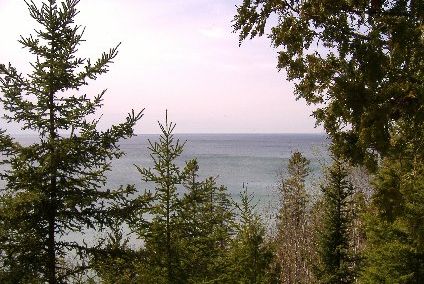 | ||
Pam Member Username: Pam Post Number: 286 Registered: 11-2005 Posted From: 4.229.102.15 |
Pun intended?  | ||
Livernoisyard Member Username: Livernoisyard Post Number: 1026 Registered: 10-2004 Posted From: 69.242.223.42 |
And is twig a branch of math? | ||
Eric_c Member Username: Eric_c Post Number: 789 Registered: 11-2003 Posted From: 68.76.202.10 |
I have to vouch for the Liberty Elms, too. Maybe three years ago, circumstances were such that our landlord at the time gave my wife and I the opportunity to choose trees to replace two diseased Ash removed by the city. I had always been an Elm fan and thus chose the Liberty from Elm Research Institute (ERI). We planted three footers with trunks about the size of a fat pencil and they took right off. Just this last weekend, I drove past the old place and MAN had the trees grown! In three years, the trunks now appear to be at least four inches in diameter and they looked to be every bit of twelve feet tall. Pretty cool, I thought. BTW, ERI offers "group" rates for those who wish to help them with their mission of replanting American urban forests. | ||
Ventura67 Member Username: Ventura67 Post Number: 47 Registered: 12-2003 Posted From: 68.41.239.143 |
Great thread! Without a doubt my favorite Detroit tree is the ailanthus, or "tree of heaven". It is the ubiquitous tree of the ghetto. I really do think it is a nice looking tree, and though it is now seen as a ghetto tree, old pictures of Detroit's mansions show they were once used ornamentally on front lawns, often right in front of the house. The Ransom Gillis house had 'em in 1890, and still had 'em in 1990. Funny stuff!!!  | ||
Mackinaw Member Username: Mackinaw Post Number: 1837 Registered: 02-2005 Posted From: 75.10.21.237 |
Yeah I would look into those liberty elms, which appear to be alot like the originals. Yeah Pam, definitly a pun haha. Those were some nice spruces in the photo hysteria. Here's the awesome white pine, often growing over 100 feet, with only a few virgin tracts left in Michigan. 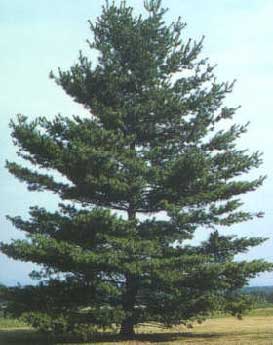 I have one in my yard that grows several feet per year, currently in perfect health despite warnings about them being prone to pollution (I'm due east of the incinerator for cripes sake), it's poised to be a stately sentintel like this: 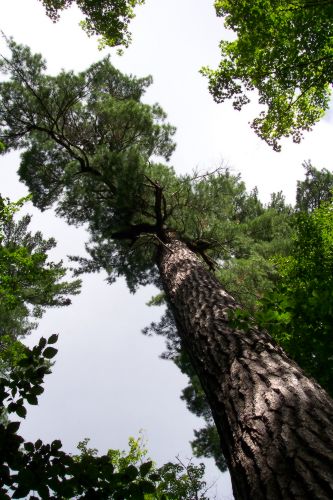 | ||
Ray1936 Member Username: Ray1936 Post Number: 686 Registered: 01-2005 Posted From: 207.200.116.139 |
Great photos, Mike, if somewhat sad to view. A good windstorm is likely to make them all history, as well as anyone unlucky enough to be walking by at the time. Mackinaw, pine trees are a NIMBY. They are beautiful to look at when they are on someone else's property, but most of them really make a mess on a manicured lawn with the falling needles. They can easily lay a carpet two inches thick if not maintained. Not to mention the dang pine cones that fall all over the place. Ventura67, "ubiquitous tree of the ghetto" is an apt description. They'll grow anywhere in a wild pattern of branches. I think if someone were to prune and trim one regularly, they might be more attractive than they generally appear. I imagine some of the skyscraper trees in the loop are ailanthus; I've not really paid attention to species. In my back yard in Rosedale Park years back stood a majestic red maple. I'd guess it was planted when the house was built in 1937. Just a huge tree, and when we moved from there in '84 I picked a leaf from it to remember it. I framed it under glass along with a photo of the house and lot, and have it here in the desert today to remember my years of wine and roses. | ||
Livernoisyard Member Username: Livernoisyard Post Number: 1027 Registered: 10-2004 Posted From: 69.242.223.42 |
Pine trees make great Roman candles this time of year. Could take out a nearby house, too. | ||
Hysteria Member Username: Hysteria Post Number: 698 Registered: 02-2006 Posted From: 64.12.116.204 |
Mackinaw may know this, but for others less familiar with northern Michigan, Hartwick Pines State Park (Grayling area) is home to a virgin white pine forest. I believe it's the largest state park in the lower peninsula. Many white pine trees from this area were used to rebuild Chicago after the great fire. | ||
Machoken Member Username: Machoken Post Number: 1373 Registered: 10-2003 Posted From: 68.61.100.126 |
I guess you could prune and trim a tree of heaven, but you'd want to wear a decent gas mask while you're doing it, and hey if you find you like the odor eventually your whole yard will be overcome with the darned things if you let it. Speaking from experience... I knocked three of them down 3 years ago and still this summer I've seen a few of them sprouting up from the old roots. | ||
Mackinaw Member Username: Mackinaw Post Number: 1838 Registered: 02-2005 Posted From: 75.10.21.237 |
If you surround a pine tree(s) with a shade garden, though, you're in good shape. Hartwick Pines has the best White Pines left in the lower peninsula. Toward the tip of the mitt they've bounced back nicely since the era of deforestation, mainly in lowland areas, however spruces and aspens still fill much of the balance of these second-growth forests. Where you need to go is the Porcupine Mountains in the western UP, tons of Hemlock and White Pine there. Also, the Keewenaw Peninsula is split between protected and unprotected forests, but it is really beautiful and you can see the Estivant Pines sanctuary of huge virgin pine near Copper Harbor (11 hours from Detroit!) The Huron Mountains area is supposed to be outstanding (hard to access), and then there is the Ottawa National Forest in the western UP toward the Wisconsin border. | ||
Jjaba Member Username: Jjaba Post Number: 4059 Registered: 11-2003 Posted From: 67.171.136.201 |
MikeM, were all of your beautiful shots Eastside? It sure looked like it. jjaba, lol. | ||
Michikraut Member Username: Michikraut Post Number: 167 Registered: 05-2004 Posted From: 217.232.69.29 |
My Grandfather lost a couple of Elms back in the 70´s-was really upset to cut them down as him and his brother had a thing for trees. Especially Walnut trees- George his brother, actually recieved several awards for all the Black Walnut Trees he donated and planted. I think many people don´t plant Oaks and Walnuts not only because of the nuts but also because they are a slow growing tree- takes quite a while before they start looking substantial. In the front of Grandpas house(still in family) are two huge Katalpa trees- have really pretty(and strong perfume) flowering bunches in early summer, later than most blooming trees, but then in late fall- they litter the lawn with long seed pods that have to be raked before mowing as they can clog the blades. One was struck with lightening back in the late 70´s and my Dad and Grandpa climbed up in the tree and with a cinch pulled the tree back together and wrapped some steel cables around the split. The tree kept growing (now around 4-5 foot diameter) and the wound is pretty much closed over. They are pretty but a lot of work. Still worth it. My Dad taking after his dad, has started planting trees (is that something retired men do???) and has planted a few "liberty Elms" and some of his favorites are Lindens and Chestnuts. | ||
Southwestmap Member Username: Southwestmap Post Number: 511 Registered: 01-2005 Posted From: 70.229.231.102 |
Regarding tree planting: The first year they sleep The second year they creep The third year they leap | ||
Pam Member Username: Pam Post Number: 287 Registered: 11-2005 Posted From: 67.107.47.65 |
This is a nice thread so far. I wonder if any of the right wingers will break in and accuse everyone of being a bunch of commie tree huggers?  | ||
Mackinaw Member Username: Mackinaw Post Number: 1839 Registered: 02-2005 Posted From: 75.0.88.243 |
haha I thought for sure that would happen... well, I'm a Teddy Roosevelt-style conservationist (minus the going on hunting safaris part), so there are at least a few right wing tree huggers out there. | ||
Hysteria Member Username: Hysteria Post Number: 701 Registered: 02-2006 Posted From: 216.223.168.132 |
I need to get back up there - it's been a few years. I would like to go to Isle Royale someday. | ||
Mackinaw Member Username: Mackinaw Post Number: 1840 Registered: 02-2005 Posted From: 75.0.88.243 |
Me too, I've been to the Keewenaw alot, but never to IRNP. I have to say our state of Michigan would be pretty boring without having the UP to explore. The western UP is so much different, more rugged, different types of people. The cities (Houghton-Hancock, Marquette, and Munising specifically) are etched into the landscape...in most cases, spaces just can't be clear cut and leveled like in the lower peninsula. | ||
Jsmyers Member Username: Jsmyers Post Number: 1790 Registered: 12-2003 Posted From: 209.131.7.68 |
Unfortunatly, there is a lot of leveled area south of Houghton on M-26. I went to MTU, spent 12 days backpaking on IR after my second year. My companions and passed another group the morning we were hiking west passed Minong Mine and didn't see another person until the afternoon 2 days later. It was early in the season. http://www.nps.gov/isro/parkma p.htm | ||
Gistok Member Username: Gistok Post Number: 2396 Registered: 08-2004 Posted From: 4.229.72.16 |
Jsmyers, you are oh so right about the Silver Maple trees.... I have an 80 footer in front of the house, and I hate it!!! Surface tree roots everywhere, and I had to have my sewer line to the house dug up twice because of them. The city (SCS) said that if I have it cut down, the root system won't die for another 5 years. The only positive thing it does is shade the house in the AM. | ||
Gistok Member Username: Gistok Post Number: 2397 Registered: 08-2004 Posted From: 4.229.72.16 |
My 2 all time favorite trees in Detroit are the 2 Camperdowne (sp?) Elm trees in front of the DIA. IIRC, they were imported (at $50,000 each) from Scotland back in the 1980's, but one died and had to be replaced. They are beautiful trees! | ||
Jsmyers Member Username: Jsmyers Post Number: 1791 Registered: 12-2003 Posted From: 209.131.7.68 |
I had one in Ann Arbor drop a 10'x6" dia branch on my old Saturn....and it wasn't even windy. They are a fast growing lowland tree. Other maples grow more slowly and are more suited to uplands. Id say that a silver maple is better than no tree though. Are there other trees that have a similar size and form to Elms that can be planted with them to increase diversity but not change the landscape design created by them? | ||
Mackinaw Member Username: Mackinaw Post Number: 1846 Registered: 02-2005 Posted From: 75.0.88.243 |
apparantly, Zelkova trees or "Japanese Zelkova"...might be spelling it slightly wrong. It was a popular planting on my street after the Elms. Similar leaves, and supposed to have a vase-like shape when mature. They aren't supposed to be as tall. The oldest ones around are only middle age, so I can't give an opinion, other than that they provide tons of shade and are hardy. | ||
Gistok Member Username: Gistok Post Number: 2398 Registered: 08-2004 Posted From: 4.229.105.165 |
What is that tree that I see along Lakeshore Dr. in the Grosse Pointes and elsewhere that has a cluster of ivory colored flowers in June? The clusters resemble clusters of grapes, with clusters about a foot long. Those trees grow pretty tall, I've seen them at up to 100 feet tall. I just don't know the name of them... (I know they're not Wisteria). (Message edited by Gistok on July 06, 2006) | ||
Mikem Member Username: Mikem Post Number: 2634 Registered: 10-2003 Posted From: 68.43.15.105 |
Catalpa? | ||
Jjaba Member Username: Jjaba Post Number: 4068 Registered: 11-2003 Posted From: 67.171.136.201 |
Gistok, sounds like Catalpa. It has a very large leaf, with a seed pod hanging down which should not be smoked. Its bloom sounds like you've described. They can get very big and bulky. They are in the trumpet creeper family with pale showy flowers in terminal clusters. MikeM, where are those dead trees featured in your photomontage? jjaba has money on Eastside. jjaba. | ||
Mikem Member Username: Mikem Post Number: 2635 Registered: 10-2003 Posted From: 68.43.15.105 |
All over; I can't remember exactly. West side probably along Buchanan or Scotten, Brightmoor, and possibly around Wesson south of Kelsey-Hayes; lower east side around Jefferson-Chalmers, north side of Hamtramck, and far east side around Kelly & Seven Mile and along E State Fair? One street sign says "Sharon"...probably between Fort & W Vernor. | ||
Jjaba Member Username: Jjaba Post Number: 4071 Registered: 11-2003 Posted From: 67.171.136.201 |
Ok, with apologies to the Eastside. Westside has standing dead big blue Xs too. jjaba. | ||
Ventura67 Member Username: Ventura67 Post Number: 49 Registered: 12-2003 Posted From: 68.41.239.143 |
I was up at the Estivant Pines Sanctuary two weeks ago. A very beautiful place with amazing White Pines, anyone who wants to appreciate Michigan's lost White Pines should see them. It's the really big, dead fallen ones (which you'll see almost nowhere else) that really make you go "Damn, what a huge tree!" I hugged alot of them. | ||
Gistok Member Username: Gistok Post Number: 2401 Registered: 08-2004 Posted From: 4.229.81.217 |
Thanks Jjaba & Mikem.... I don't think the eastside has a Monopoly on what could be dead Ash trees... It's sad to see so many Ash trees dying all over the metro area. They get those shoots coming out nearer the base as a desperate but futile attempt to circumvent the Emerald Ash Borers damage. | ||
Harsensis Member Username: Harsensis Post Number: 63 Registered: 07-2005 Posted From: 71.227.102.82 |
Grosse Pointe Farms has about 8 or so of the new elms growing and when they get big enough they are going to plant them around town. I have been looking and the Liberty and Princeton Elms which are both resistant to the Elm Disease. I agree with Mackinaw that a nice spot to see some of the old elms is Ridge between Kerby and Vendome in GP. I only live a block away from there and they are so nice to look at. | ||
Jerome81 Member Username: Jerome81 Post Number: 1035 Registered: 11-2003 Posted From: 64.142.86.133 |
So was the dutch elm disease not known about when all the elms were planted way back when? Or were they just crossing their fingers they wouldn't get it? The should start planting the resistant ones all over the city again! | ||
Mikem Member Username: Mikem Post Number: 2644 Registered: 10-2003 Posted From: 68.43.15.105 |
While out on a bike ride, I scooped up a handful of seeds from those Ridge Road elms, and have them growing at home. I hope they share the hardiness of the parent trees and will shade my backyard by the year 2086. | ||
Lowell Board Administrator Username: Lowell Post Number: 2775 Registered: 10-2003 Posted From: 66.167.211.36 |
LOL @ MikeM. Great Pics and foresite to collect those! | ||
Gannon Member Username: Gannon Post Number: 6128 Registered: 12-2003 Posted From: 70.236.198.22 |
Great thread, dunno how I missed this in the past few days... Appoline of my youth, between Belton and Oakman (after it curves east just north of Tireman), smack dab in the middle of the Aviation subdivision was one of those regal cathedral-topped streets...providing SO much shade that we constantly had a convoy of city trucks parking there for their lunch breaks. One of my earliest childhood memories is when the GI Joe's came to life and occupied the cathedral during the '67 and '68 summers...one of the old armories was down at Tireman and Greenfield, I think. I remember when they all came down...but I think Freda street near Wyoming still has a decent cover of elms, if I remember correctly. I drove down ol' Appoline just yesterday...found myself in the old neighborhood, and yearned to run those S-curves on Littlefield...and saw that my old castle house is still there with the SAME aluminum siding and garage that my dad added, heh...some thirty-odd years later. Odd years, indeed. Great memories, great discussion. | ||
Magic_mushroom Member Username: Magic_mushroom Post Number: 8 Registered: 12-2005 Posted From: 24.220.197.208 |
I now live in Bismarck, ND and we have many spectacular Elms. Many of the streets have the tunnel look in certain sections of town. We have been very fortunate to have missed out on the Dutch Elm epidemic. They have a very potent Dutch Elm disease quarantine plan and take swift action at any possibly infected tree, removing them and destroying them at once. | ||
Danny Member Username: Danny Post Number: 4504 Registered: 02-2004 Posted From: 141.217.174.229 |
That's what you get if you all bring exotic fauna and flora into another habitat. Imports from various foreign trades is main cause for DUTCH elm disease, The Emerald Ash Boar beetle and of course the Asian Longhorn bettle to plague the trees in Chicago. |